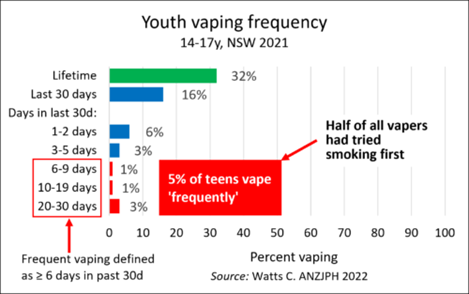
Frequent vaping by teen non-smokers is very uncommon in Australia
Posted on August 23, 2023 By Colin
ONLY ONE IN TWENTY 14-17-year-olds in Australia vapes 'frequently' and half of these were already smokers, according to Australian research. Frequent vaping was defined as weekly, or 6 days or more per month in the two studies.
This is a far cry from the alarmist media headlines of a youth vaping 'epidemic' and a 'new generation addicted to nicotine'.
From a health point of view, the main concern is for never-smoking teens who vape frequently as only this group is at-risk from new and potentially harmful inhaled chemicals.
Less than 3% of 14-17-year-olds vape 'frequently' but have never smoked
Vaping rates are often given as ever or lifetime vaping or past-12 month vaping, but these measures over-estimate the rate of frequent vaping as most teen vaping is experimental and short term. Many vape only once or twice, or every now and then. This group is at no or little risk of harm.
Many young people who vape were former or current smokers who turned to vaping as a safer alternative or as a quitting aid, according to the National Drug Strategy Household Survey. Smokers who switch to vaping are likely to have improved health. Some others who vape would have smoked instead if vaping was not available.
The research
A study by Watts in 2022 of 721 youth aged 14-17-years in NSW found that 16% had vaped in the last 30 days. However, more than half vaped on only 1-5 days in the month. Of the total sample only 5% were vaping frequently (defined as 6 times or more in the last 30 days).

The study reported that 54% of teens who vaped were not smokers when they started vaping. Therefore only 2.5% were non-smokers who vaped frequently.
Another survey by Gardner of 4,204 school students aged 14-17 years published in 2023 found similar results. This study surveyed youth in NSW, Queensland and Western Australia found that 10.1% had vaped in the past 30 days. However, only 5.7% were frequent vapers, ie had vaped at least weekly.
The smoking status of vapers was not identified, but assuming the same proportion were non-smokers as in the Watts study (54%), the rate of frequent vaping by non-smokers would be 2.8%.

Furthermore, many young vapers do not use nicotine. Watts found that only 37% were using nicotine, although 27% did not know if they if they were using it or not. Not using nicotine reduces the risk of developing nicotine dependence and lessens the concerns about youth vaping.
Comparison with other countries
The very low rate of frequent vaping by non smoking youth in Australia is similar to other western countries, although definitions of vaping frequency vary.
- England: 1% (≥ once weekly) 2021
- United States: 2.1% (≥ 20 days in the last 30 days) 2019
- New Zealand: 4.3% (daily) 2022
Declining vaping rates
It is likely that vaping is another youth fad which will settle over time. Youth vaping is declining or levelling out in some countries where vaping has been established for some years.
For example, in the US, youth vaping rose to a peak of 27.5% of high schoolers in 2019. By 2022, the vaping rate had declined by over 50% to 14.1%.
Similarly in New Zealand, the rise in vaping by never-smokers is starting to flatten out as the new regulations take effect. However, youth vaping rates are still rising in Great Britain.
Exaggerated concerns about youth vaping
Concerns about the harms of youth vaping are greatly overblown by the media and Australian public health organisations and we need to change the way we look at youth vaping. Overall, vaping may be beneficial to young people.
Not only is frequent vaping by youth who have never smoked very uncommon, but the harms are relatively small.
However, the key issue is that vaping is improving public health overall by diverting young people away from deadly smoking
Increases in youth vaping have been accompanied by accelerated declines in smoking in the United States, the United Kingdom and New Zealand.
Many young non-smokers try vaping instead of smoking. Other smokers quit smoking by switching to vaping, a much less harmful alternative.
Vaping is not recommended for non-smokers, especially young people. However, frequent vaping is very uncommon among non-smokers, is doing relatively little harm to health and is likely be improving youth health overall.
Go to Top